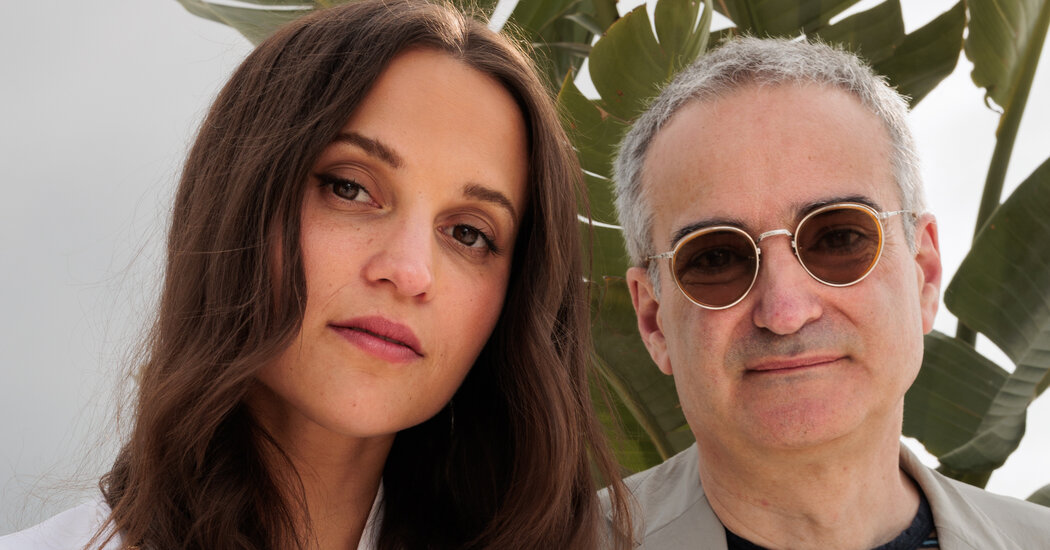
Most shows fall within recognizable categories: original stories, spinoffs, docudramas or, increasingly, reboots and revivals.
Then there is “Irma Vep.” Olivier Assayas’s new HBO series, starring Alicia Vikander, is more like a braid in which the past and the present are inextricably intertwined. Its origins go back more than a century, though it will be more helpful to start our story in 1996, when a film bearing the same title came out.
Back then, Assayas was a former critic turned filmmaker with a handful of intimate art-house dramas under his belt. “Irma Vep” brought him international acclaim.
Not because it was a commercial hit, mind you. The movie “didn’t make exactly a splash at the box office,” the French writer-director said in a video conversation from his office in Paris last month. “It didn’t do that great.”
What “Irma Vep” had in spades, however, was cool.
This was thanks partly to its meta subject matter. The real-life Hong Kong action star Maggie Cheung — to whom Assayas was later married for a few years — played a version of herself shooting a remake of “Les Vampires” (1915-16), a French silent film serial, by Louis Feuillade, about a disguise-loving criminal named Irma Vep.
And then there was Assayas’s fingers-in-socket style, which generated such memorable scenes as Cheung anxiously fidgeting in a black latex catsuit as Sonic Youth rained electricity on the soundtrack.
“I think it’s a movie that a lot of people hold dear, especially because it’s about cinema,” Ravi Nandan, the head of TV at A24, the production company behind the series, said on the phone from Los Angeles. “So people inside of filmmaking, both Hollywood and independent cinema, have all seen it and loved it.”
“It’s sort of like a touchstone in that Truffaut, ‘Day for Night’ sort of way,” he added.
The series, which premieres Monday on HBO, is not a sequel sliced up into eight episodes; Assayas goes for a literary analogy when trying to explain the project’s nature. “Turning ‘Irma Vep’ into the new ‘Irma Vep’ is like moving from poetry to novel — and to a thick novel,” he said. (While the show works on its own, the matryoshka doll structure is more rewarding if you have seen the movie, which is currently streaming on HBO Max and the Criterion Channel.)
That this was not a rehash was among the reasons Vikander signed on. “He was like, ‘No, no, it’s just a continuation of it — I’m not finished with it yet, that’s why I’m interested in doing it,’ ” she said in a video chat from London, recalling Assayas’s pitch. “I could see that he had that small fire within him.”
Another reason was their friendship: The pair met when he thought he had to recast his 2016 film “Personal Shopper” because its intended lead, Kristen Stewart, had a scheduling conflict. In the end, Stewart was able to free herself and make that movie, but Assayas and Vikander stayed in touch. When the series took shape, the Swedish actress was his first choice for the lead character of Mira, a Hollywood star who goes to Paris to shoot a remake of an old silent film serial about — well, you’ve heard this one before.
“I had a feeling that she had not unleashed her full potential,” Assayas said of Vikander. “I thought she’s funny, she’s smart, she’s quick, she has this profound understanding and love of movies. I felt that the combination of us two, something could happen.”
Vikander, who first drew wide notice for playing an android in “Ex Machina” and won an Academy Award for the period drama “The Danish Girl” (2015), is not generally known for lighthearted material. So, the comic dimension of “Irma Vep” was part of the attraction.
“I was longing to do that,” she said, laughing in delight. “And I think Olivier knew that from knowing me, my private persona. He was like, ‘Yeah, you need to let that out more.’ I think that this is just the beginning.”
In the show, the humor usually bubbles up in conjunction with the antics of the French cast and crew Mira is working with, led by the mercurial René Vidal (Vincent Macaigne), a neurotic, cinema-obsessed director who has already made a movie about Irma Vep (starring a Chinese actress named “Jade Lee” as a stand-in for Cheung) and is now back at it with a series. Amusingly, Macaigne’s speaking cadence often sounds like Assayas’s, and while the director agrees that he’s partly written himself into René, he said he is nicer.
“I don’t scream at people, you know,” he said, laughing. “I don’t attack my actors.”
Still, it’s clear that parallels between art and life are woven into the new show’s fabric. And each iteration of “Irma Vep” brings additional, increasingly complex ripples of self-reference. “I’m part of the story of the character Irma Vep in the sense that it starts with Louis Feuillade in 1916, and it travels through cinema up to the present,” Assayas said.
“I like the idea of layers of time combining in the movie, which is not something you can do very often,” he continued. “And there is the relationship to my own work, how it ages, how I interact with myself a quarter of a century apart, how the events surrounding the film — which, to be transparent, is my marriage to Maggie Cheung — is also something that echoes very profoundly and essentially with the goings-on in the series. And how also modern cinema has a dialogue with silent film.”
As for Mira, many viewers might assume she’s a stand-in for Stewart — we first see Mira arriving in Paris wearing shades and a slouchy beanie, nursing a broken heart after being dumped by her girlfriend. It’s a resemblance Assayas both soft-pedals and does not refute.
“There’s a little bit of it but not really,” he said. “This was written with Alicia in mind, but then you can’t escape the fact that my experience of an American movie star is Kristen Stewart. I don’t know that many of them, and she’s a friend, and I love her and I admire her. So yes, there must be elements of Kristen — Kristen is haunting the film.”
As for Vikander, her identification with her character also had limits. “Probably one of the things with Mira that I can mostly relate to is maybe her passionate love for cinema,” she said. “But it was also fun doing it with a character that is quite different from me.”
But the new “Irma Vep” is more than a series à clef, or a mere patchwork of references to other stars and other films. Under its playful manner and some very funny side plots — one, in particular, involves the need to source crack cocaine for an addled actor — Assayas continues to explore what was at the heart of the 1996 movie.
“The series is about the thin line between reality and fantasy; it’s about how we all live simultaneously in a material world and an immaterial world,” he said. “When you’re directing, when you are acting, you are playing a dangerous game, in a certain way, with your identity — you are being yourself and you are being someone else, and you struggle to bring out as much truth as you can.”
For Mira, a passageway between her regular life and the land of make-believe is Irma Vep’s catsuit, here rendered not in latex but in a silky fabric closer to the serial’s version. As with the fictionalized Cheung in 1996, the costume connects Mira to Irma. (By now you surely have noticed that their names are an anagram, which is yet another reference to the source material.)
It comes as little surprise to learn the catsuit’s spell worked on the series’s star, too. “You’re extremely visible because it’s so body-tight, but I also feel like a ninja — I just disappear,” Vikander said. “When I was in this whole black thing, I really immersed and really enjoyed doing it. It felt like the physicality of the part.
“It was one of those things that I had thought about a lot, but when I first tried on the costume,” she continued, snapping her fingers, “she just appeared.”




